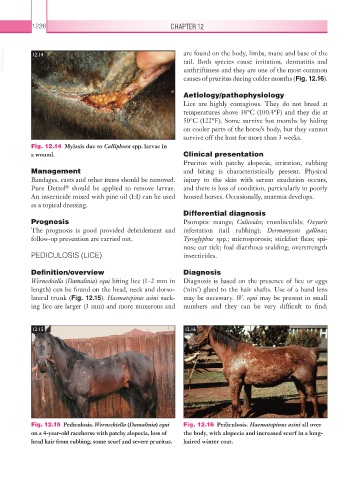Page 1251 - Equine Clinical Medicine, Surgery and Reproduction, 2nd Edition
P. 1251
1226 CHAPTER 12
VetBooks.ir 12.14 are found on the body, limbs, mane and base of the
tail. Both species cause irritation, dermatitis and
unthriftiness and they are one of the most common
causes of pruritus during colder months (Fig. 12.16).
Aetiology/pathophysiology
Lice are highly contagious. They do not breed at
temperatures above 38°C (100.4°F) and they die at
50°C (122°F). Some survive hot months by hiding
on cooler parts of the horse’s body, but they cannot
survive off the host for more than 3 weeks.
Fig. 12.14 Myiasis due to Calliphora spp. larvae in
a wound. Clinical presentation
Pruritus with patchy alopecia, irritation, rubbing
Management and biting is characteristically present. Physical
Bandages, casts and other items should be removed. injury to the skin with serum exudation occurs,
Pure Dettol should be applied to remove larvae. and there is loss of condition, particularly in poorly
®
An insecticide mixed with pine oil (1:1) can be used housed horses. Occasionally, anaemia develops.
as a topical dressing.
Differential diagnosis
Prognosis Psoroptic mange; Culicoides; trombiculids; Oxyuris
The prognosis is good provided debridement and infestation (tail rubbing); Dermanyssus gallinae;
follow-up prevention are carried out. Tyroglyphus spp.; microsporosis; stickfast fleas; spi-
nose ear tick; foal diarrhoea scalding; overstrength
PEDICULOSIS (LICE) insecticides.
Definition/overview Diagnosis
Werneckiella (Damalinia) equi biting lice (1–2 mm in Diagnosis is based on the presence of lice or eggs
length) can be found on the head, neck and dorso- (‘nits’) glued to the hair shafts. Use of a hand lens
lateral trunk (Fig. 12.15). Haematopinus asini suck- may be necessary. W. equi may be present in small
ing lice are larger (3 mm) and more numerous and numbers and they can be very difficult to find;
12.15 12.16
Fig. 12.15 Pediculosis. Werneckiella (Damalinia) equi Fig. 12.16 Pediculosis. Haematopinus asini all over
on a 4-year-old racehorse with patchy alopecia, loss of the body, with alopecia and increased scurf in a long-
head hair from rubbing, some scurf and severe pruritus. haired winter coat.

